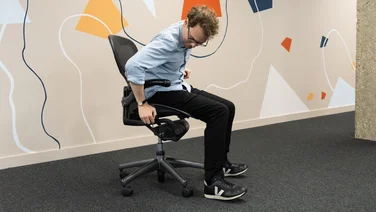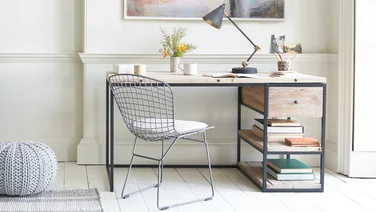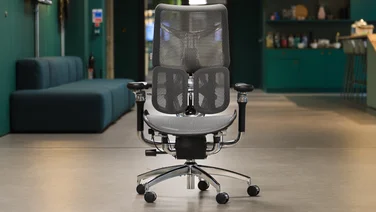To help us provide you with free impartial advice, we may earn a commission if you buy through links on our site. Learn more









- Comfortable, spacious seat
- Good seat tilt feature
- Easy to adjust
- No adjustable lumbar support
Having tested both the Nubi and the EP460 last year, I’m starting to get to grips with Boulies’ range of office chairs. The Boulies OP300 on trial here is another one of the brand’s mid-range models, and promises to deliver “a truly ergonomic working experience”.
The OP300 achieves this to an extent: it’s a comfortable and supportive office chair that has a number of adjustable features, including a decent seat tilt. But it lacks an adjustable lumbar support, which is disappointing for a chair at this price.
What do you get for the money?
The Boulies OP300 is available with one of two backrest types: a standard mesh material or a softer padded mesh for a little extra cushioning. Regardless of which you choose, the chair will cost you £290 at full price.
In terms of aesthetics, there’s one colour option: black. Sure, it’s not the most exciting, but this is an office chair, not a sofa, and what could be a better workspace palette than cool, corporate black?









There aren’t too many surprises when it comes to the OP300’s adjustable features, either. There’s seat height, seat depth, backrest tilt and arm angle/depth adjustments, as well as a seat angle adjustment and a “rocking function” that allows for a greater versatility of movement compared to other chairs with a similar feature.
The included headrest also offers a decent amount of adjustability, but while you can adjust the backrest, there’s no adjustable lumbar support to speak of.
What did we like about it?
The OP300’s foam seat is comfortable and spacious. In fact, with a width of 52.5cm, it’s the widest seat of all the office chairs we’ve tested, followed closely by the Orangebox Do Better’s 52cm seat. I tested the version with the mesh backrest, so I can’t speak for the comfort of the padded variant, but I found the mesh to be more than comfortable for long periods of sitting.
Self-assembly was very simple and I managed to put the OP300 together unaided in around 15 or 20 minutes. The manual’s instructions are clear, but I would have appreciated it if the screws had been labelled in their packaging – at first glance, it was quite tricky to differentiate the M6 x 35mm and M8 x 20mm screws.









Once you’ve put it together, the chair is easy to use, too. Most of its adjustable features can be operated via three levers on the right-hand side of the seat base. This was all very straightforward to get to grips with, which is something that couldn’t be said for the FlexiSpot C7.
There’s not much to add about the seat height and backrest tilt adjustments. Instead, the feature that stood out during testing was the seat tilt function. Now, I’ve reviewed chairs that offer a forward tilt feature – including the Herman Miller Aeron and the Boulies Nubi – which is particularly useful if you’re using a laptop at your desk.









The OP300 takes things a little further, though: by raising the middle of the three adjustment levers, you have full freedom to tilt the seat between 7.8° and -1.7° and to lock it in any position between these two extremes by lowering the lever again. You can also use the seat tilt lever and the backrest lever in tandem to engage the OP300’s “rocking function”: with both levers raised, the seat and backrest tilts are unlocked, allowing you to move with complete freedom. It’s a much more versatile system than the Nubi’s two-position forward tilt feature and it worked very well to help me maintain a natural, healthy posture while working.
Another area in which the OP300 excels in terms of versatility is the headrest. I’m normally not a fan of headrests, but I must admit that there’s a decent amount of customisation here: not just height and tilt but also depth.
What could be improved?
My biggest issue with the Boulies OP300 was the absence of an adjustable lumbar support. This is an omission that’s shared with the Nubi, but it feels more glaring here. For an ergonomic office chair that offers so many other adjustable features, neglecting even a basic adjustable lumbar support feels like quite a big oversight, especially for a chair that costs almost £300.









You can adjust the height of the backrest, which has the knock-on effect of moving the position of its curvature and the otherwise static lumbar support. But this isn’t an ideal stand-in for a dedicated adjustable lumbar support, because it means you’re also shifting the height of the shoulder support and headrest. You’re also unable to tweak the depth of the lumbar support as you can with many ergonomic rivals.
Why is all this an issue? Well, while I still found the OP300 to be a comfortable chair and the curved shape of its backrest to be supportive, my build might not be the same as yours. A lumbar support that can be adjusted in height and depth would help make the chair more suitable for a range of different postures, needs and body shapes. And I would argue that for a chair to be truly “ergonomic”, it’s an essential feature.
Should I buy the Boulies OP300?
The Boulies OP300 has a lot of good things going for it: its cushioned seat is comfortable and offers more than enough space; it’s easy to adjust via three intuitively positioned levers; and its seat tilt mechanism is a great feature.
The main obstacle standing in the way of an award is the lack of adjustable lumbar support. a disappointing omission that prevents a wholehearted recommendation. I found the chair’s default position comfortable and supportive, but you might not.
If an adjustable lumbar support is equally important to you, one of our favourite office chairs, the Slouch Task One, might be a good option for you, although it doesn’t offer some of the other ergonomic adjustments that the OP300 does. Both the Sihoo M57 and the Orangebox Do Better also have adjustable lumbar support.














